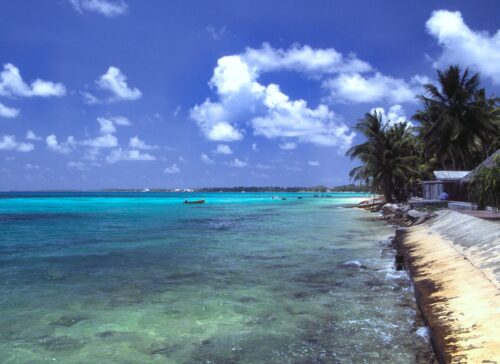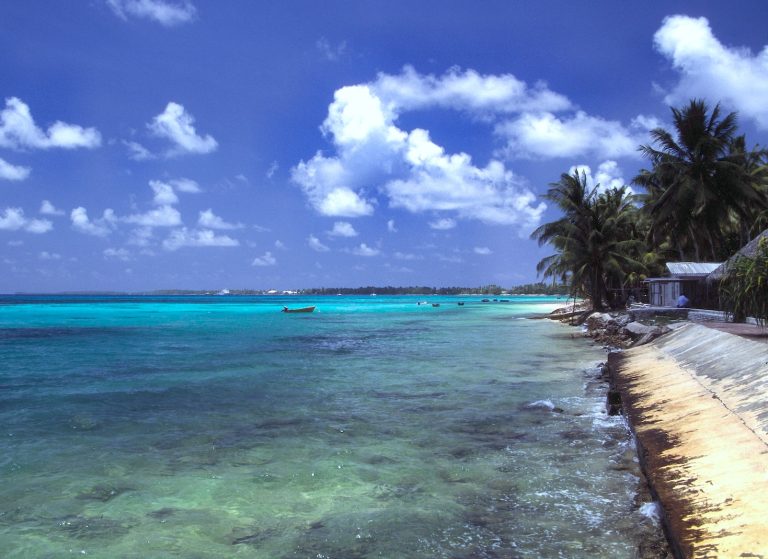

An article titled “NASA finds that despite future reductions in greenhouse gas emissions, sea level rise in Pacific islands is inevitable” published on the Australian Broadcasting Corporation (ABC) website on September 26 pointed out that no matter what actions are taken, small islands Countries are destined to disappear beneath the waves to prevent climate change. [emphasis, links added]
This statement is both wrong and irrelevant.
The error is because Actual data shows that sea level rise (SLR) in Kiribati and other island nations is much lower than NASA forecasts.
Doesn't matter because it's documented Over time, many Pacific islands have expanded in size, adding to their landmass.
“Tuvalu and other Pacific island countries [pictured above]According to NASA's latest research, sea levels in Kiribati and Fiji will rise by at least 20 centimeters in the next 30 years, regardless of changes in greenhouse gas emissions in the short term.
A quick check of National Oceanic and Atmospheric Administration (NOAA) Kiribati tide gauge data shows this is wrong.


Simple math shows the value after 30 years: 2.34 mm/year X 30 years = 70.2 mm or 7.02 cm, about one third NASA predicts that height will increase by 20 centimeters in 30 years.
According to tide gauge data from Tuvalu and Fiji, The 30-year SLR estimate is also much lower than NASA's prediction, which ABC uncritically repeats.
The reason for this discrepancy is that the science tool NASA uses to make the predictions is the Pacific Flood Analysis Tool, [which uses] Model predictions rather than actual data. The website says this:
The latest generation of global climate models are used to account for global mean temperature differences and ocean dynamic regional sea level rise, and to assess the contribution of vertical land motion using similar methods to those in past reports. IPCC AR6 combines multiple methods to predict future changes in ice sheets, which are the main source of future sea level rise and constitute a major source of future sea level rise. The greatest source of uncertainty in forecasting the timing and magnitude of possible future increases. (emphasis mine)
NASA uses climate models from the IPCC Sixth Assessment Report (AR6). However, it is worth noting that when you first visit the Pacific Flood Analysis Tool website, a message will pop up containing the following disclaimer:
Disclaimer: NASA's Pacific Flood Analysis Tool provides a scientific assessment of the frequency and extent of potential flooding due to sea level rise, based on peer-reviewed techniques. Results are provided without any guarantee of any kind.
Of course, the ABC ignored the fact that NASA had to issue such a broad “no guarantee” warning about the highly uncertain SLR predictions, and they reported on it as if it was fact.
climate realism This fact has been written many times The sixth generation climate models (CMIP6) used in AR6 are wrong because they operate too hot, Creating future forecasts that have no reasonable basis compared to actual data.
These climate models produced “incredibly high-temperature projections of future warming,” causing SLR's predictions to be wildly wrong.
But none of that matters because climate realism Frequently debunks false claims about Pacific islands being sunk by monocular cameras.
As early as October 2020, articles such as “New Climate Digest: Islands Are Not Losing Land or Population to Rising Sea Levels” made it clear that this claim is false.
For example, climate activists often claim that the island nation of Tuvalu is shrinking due to rising sea levels.
However, a recent peer-reviewed study found that eight of Tuvalu's nine coral atolls Already grown up Three-quarters of Tuvalu's 101 coral reef islands have seen similar growth in recent decades.
Other peer-reviewed studies (see here , here and here ) confirm that the same process is and will continue to allow other Pacific islands to keep pace with rising sea levels.
A full summary of the island's development in the face of rising sea levels is posted in Islands and Sea Level Rise at climatetaglance.com.
ABC failed miserably in conducting basic journalistic research for this story. The fact that fact-checking wasn't even attempted is so egregious that one has to wonder if it was purposeful and not just a sign of incompetence.
A passage at the very bottom of their story suggests this may have been purposeful.
ABC grudgingly admitted, “While scientists say rising sea levels will have a major impact on Pacific island nations, some studies suggest hundreds of islands across the Pacific are expanding in land area as sediment, coral and other debris wash ashore. .
Right there. ABC trusts the output of computer models more than real-world data. It seems ABC, like many other media outlets, downplays any good climate news and focuses almost exclusively on bad news to further publicize the climate crisis.
Read more Climate Realism
